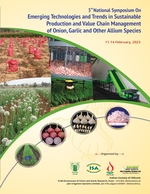Advisory For Drought
General advisory for drought/rain-fall deficit management in Onion Crop About 20% of total kharif onion is rain-fed. Rabi onion, which is the main crop (60% area) and late kharif (20% area) are grown as irrigated crops. Thus, drought/rainfall deficit has relevance mainly to kharif onion. Kharif onion crop is mainly grown in Maharashtra, Karnataka, Gujarat and some parts of Rajasthan. Following practices/strategies are recommended to manage drought situation in kharif onion crop.
a. If monsoon delayed by 15 days
This does not have much effect on the kharif onion as this crop can be transplanted from July to August. The nursery raising is rather beneficial, as onion seedlings are difficult to be raised under rains. The following strategies are suggested in this situation.
1. Varieties suitable for kharf namely Bhima Super, Bhima Raj, Bhima Red, Bhima Shubra, Agrifound Dark Red, Arka Kalyan, Arka Pragati, Baswant 780 and Phule Samarth should be grown.
2. Nursery may be raised during second week of June in such a way that seedling of about 35-40 days could be transplanted.
3. Raise seedlings on a raised bed with drip or micro-sprinkler irrigation system to use available irrigation water judiciously. In case, drip irrigation facility is not available, apply irrigation water through water sprinkler cans.
4. Seedlings should be protected by providing partial shade nets.
5. Apply stubble mulch (paddy straw/wheat straw etc.) until seed germination to avoid evaporation.
6. Apply well decomposed organic manures @ 500kg / 1000 sq. m. nursery area
7. In case of poor seedling growth, foliar application of water soluble NPK fertilizer (for example 5g/liter 19:19:19 NPK) may be given for quick recovery.
b. If monsoon delayed by 30 days
1. The strategies as listed above should be followed.
2. The other alternative can be to go for direct seeding of onion (Seed rate 8-9 kg/ha) on raised bed with drip or sprinkler irrigation system as this crop matures 1 month earlier than the seedling transplanted crop.
3. Use sets if available for raising kharif crop as this crop matures 45 days earlier than the seedling transplanted crop.
4. In case of direct sown onion, early maturing varieties namely Bhima Dark Red, Agrifound Dark Red, Arka Kalyan is recommended for this conditions.
c. Rain deficit at vegetative phase
Three to four irrigations are essential during active vegetative growth stage depending upon soil type i. e. at establishment stage (10-20 DAT), active vegetative growth stage (30-40 DAT) and bulb initiation stage (40-50 DAT). To cope up with rain deficit at this stage the following advisory is recommended.
1. Raise crop on raised beds with drip irrigation.
2. Harvest rain water by making storage ponds which will help to provide two to three life saving irrigations during drought. Irrigation water should be applied as per soil moisture level and crop requirement only.
3. Spray anti-transparent Kaolinite @ 5% to reduce water loss through transpiration as per requirement.
4. Cover soil surface with organic mulch such as paddy/wheat straw, or fodder to reduce evaporation.
5. In case of poor crop growth, foliar application of water soluble NPK fertilizer (for example 5g/liter 19:19:19 NPK) may be given for quick recovery.
6. Foliar application of sulphur 85% WP @ 1.5-2.0 g/liter for quick recovery during active vegetative growth stage.
7. Foliar application of micronutrient mixture containing Zn, Mn, Fe, Cu, B at 30, 45 and 60 DAT for better crop stand (5 ml/l).
8. Well decomposed 20 t FYM/ha or equivalent other organic manures may be applied 15-30 days before transplanting.
9. During dry spell, thrips population may increase above economic threshold level (10 thrips/plant), in that case spray Profenophos 1ml/l or Carbosulfan 2ml/l or Fipronil @ 1.5ml/l for effective management.
d. Terminal drought One irrigation is sufficient at 85 days after transplanting. That may be provided by drip irrigation using harvested rain water.
Note:
The above strategies can also be followed for late kharif and rabi crops in case of deficiency of irrigation water.















